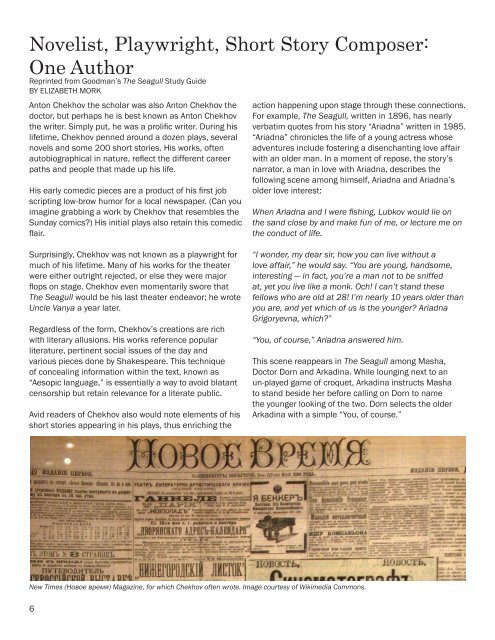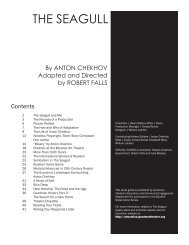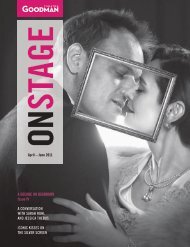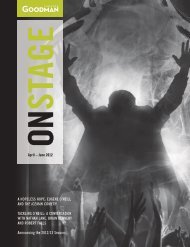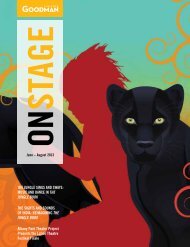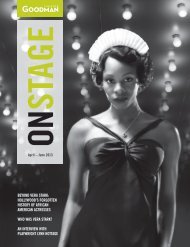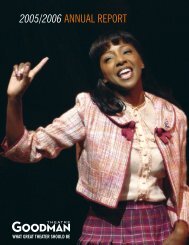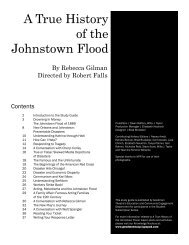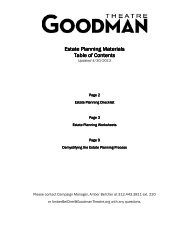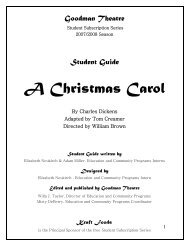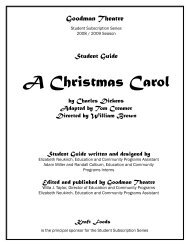El Nogalar Study Guide (9MB) - Goodman Theatre
El Nogalar Study Guide (9MB) - Goodman Theatre
El Nogalar Study Guide (9MB) - Goodman Theatre
Create successful ePaper yourself
Turn your PDF publications into a flip-book with our unique Google optimized e-Paper software.
Novelist, Playwright, Short Story Composer:<br />
One Author<br />
Reprinted from <strong>Goodman</strong>’s The Seagull <strong>Study</strong> <strong>Guide</strong><br />
BY ELIZABETH MORK<br />
Anton Chekhov the scholar was also Anton Chekhov the<br />
doctor, but perhaps he is best known as Anton Chekhov<br />
the writer. Simply put, he was a prolific writer. During his<br />
lifetime, Chekhov penned around a dozen plays, several<br />
novels and some 200 short stories. His works, often<br />
autobiographical in nature, reflect the different career<br />
paths and people that made up his life.<br />
His early comedic pieces are a product of his first job<br />
scripting low-brow humor for a local newspaper. (Can you<br />
imagine grabbing a work by Chekhov that resembles the<br />
Sunday comics?) His initial plays also retain this comedic<br />
flair.<br />
action happening upon stage through these connections.<br />
For example, The Seagull, written in 1896, has nearly<br />
verbatim quotes from his story “Ariadna” written in 1985.<br />
“Ariadna” chronicles the life of a young actress whose<br />
adventures include fostering a disenchanting love affair<br />
with an older man. In a moment of repose, the story’s<br />
narrator, a man in love with Ariadna, describes the<br />
following scene among himself, Ariadna and Ariadna’s<br />
older love interest:<br />
When Ariadna and I were fishing, Lubkov would lie on<br />
the sand close by and make fun of me, or lecture me on<br />
the conduct of life.<br />
Surprisingly, Chekhov was not known as a playwright for<br />
much of his lifetime. Many of his works for the theater<br />
were either outright rejected, or else they were major<br />
flops on stage. Chekhov even momentarily swore that<br />
The Seagull would be his last theater endeavor; he wrote<br />
Uncle Vanya a year later.<br />
Regardless of the form, Chekhov’s creations are rich<br />
with literary allusions. His works reference popular<br />
literature, pertinent social issues of the day and<br />
various pieces done by Shakespeare. This technique<br />
of concealing information within the text, known as<br />
“Aesopic language,” is essentially a way to avoid blatant<br />
censorship but retain relevance for a literate public.<br />
Avid readers of Chekhov also would note elements of his<br />
short stories appearing in his plays, thus enriching the<br />
“I wonder, my dear sir, how you can live without a<br />
love affair,” he would say. “You are young, handsome,<br />
interesting — in fact, you’re a man not to be sniffed<br />
at, yet you live like a monk. Och! I can’t stand these<br />
fellows who are old at 28! I’m nearly 10 years older than<br />
you are, and yet which of us is the younger? Ariadna<br />
Grigoryevna, which?”<br />
“You, of course,” Ariadna answered him.<br />
This scene reappears in The Seagull among Masha,<br />
Doctor Dorn and Arkadina. While lounging next to an<br />
un-played game of croquet, Arkadina instructs Masha<br />
to stand beside her before calling on Dorn to name<br />
the younger looking of the two. Dorn selects the older<br />
Arkadina with a simple “You, of course.”<br />
New Times (Новое время) Magazine, for which Chekhov often wrote. Image courtesy of Wikimedia Commons.<br />
6<br />
<strong>El</strong><strong>Nogalar</strong>.indd 6<br />
3/25/2011 4:05:32 PM


